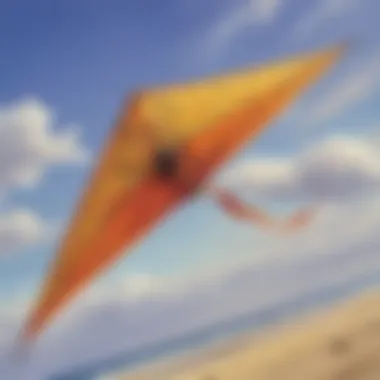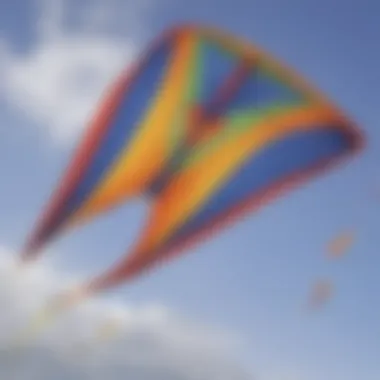Crafting a Kite: The Intersection of Aerodynamics and Aesthetics


Science Fun Facts
Designing a Kite is a fascinating endeavor that blends the principles of aerodynamics with the nuances of aesthetics. Approaching kite design with a creative mindset can lead to innovative and visually stunning results. Did you know that the shape, size, and materials of a kite play a pivotal role in its flight performance? These intricate details make kite design a perfect blend of science and art.
Discover the Wonders of Science
When delving into the world of kite design, one uncovers a treasure trove of scientific concepts. From the impact of wind speed on lift to the relationship between kite surface area and drag force, kites offer a hands-on exploration of aerodynamics. Interactive tools and simulations can further enhance the learning experience, allowing enthusiasts to grasp complex principles in a tangible manner.
Science Quiz Time
Engage in an exciting journey of learning through interactive quizzes focused on kite design. Test your knowledge on topics such as optimal tail length for stability, or the most suitable materials for different wind conditions. By solving brain teasers and unraveling design challenges, you can enrich your understanding of aerodynamics and aesthetics in kite making.
Science Experiment Showcase
Embark on a unique scientific journey by conducting experiments related to kite design. Follow step-by-step instructions to create your own model kites using various materials like bamboo sticks, plastic sheets, and strings. Ensure safety by adhering to precautionary measures during the construction process, and witness firsthand the principles of flight in action.
Introduction to Kite Design
Designing a kite encompasses a unique blend of aerodynamics and aesthetics, forming the core essence of this article. Exploring the intricacies from material selection to structural considerations sheds light on how each facet contributes to both functionality and visual allure. By delving deep into the elements of kite design, enthusiasts can elevate their flying experiences to new heights. Understanding the nuanced balance between form and function is crucial in achieving a well-crafted kite that not only soars gracefully but also captivates with its artistic appeal.
Understanding the Dynamics of Kite Flight
Kite flight dynamics are a fascinating realm where the interplay of wind patterns, shape, and weight distribution dictates the performance and behavior of these aerial wonders. The impact of wind patterns holds paramount importance, influencing how a kite maneuvers and stays aloft in varying airflow conditions. By comprehending the nuances of wind patterns, designers can optimize the kite's flight characteristics, ensuring stability and control. Moreover, the role of shape and weight distribution is a pivotal factor that affects the kite's responsiveness to wind forces. Fine-tuning these aspects can enhance the kite's aerodynamic efficiency and maneuverability, unlocking its full potential in the skies.
Impact of Wind Patterns
Embarking on the exploration of wind patterns reveals a realm where aerodynamics meets nature's forces head-on. By harnessing the distinct characteristics of different wind patterns, kite designers can tailor their creations to excel in specific flight conditions. Understanding how wind patterns influence lift, drag, and stability is imperative in crafting kites that thrive in diverse environments. Leveraging the unique features of each wind pattern allows designers to fine-tune their designs for optimal performance, whether in gentle breezes or gusty winds.
Role of Shape and Weight Distribution


In the realm of kite design, the shape and weight distribution of a kite play a crucial role in determining its flight response and stability. The geometric configuration of a kite impacts its aerodynamic profile, affecting lift generation and drag reduction. Additionally, strategically distributing weight across the kite influences its balance and agility in the air. By optimizing shape and weight distribution, designers can create kites that exhibit nimble maneuvers, swift turns, and graceful flight paths, enhancing the overall flying experience.
Historical Evolution of Kite Making
The evolution of kite making spans across civilizations, each imparting unique cultural perspectives and design innovations to this timeless craft. Tracing back the origins in ancient civilizations unveils the rich heritage and creativity that have shaped kite making over centuries. From ancient China to medieval Europe, kites have held diverse meanings and applications, reflecting the cultural significance embedded in their designs.
Origins in Ancient Civilizations
Venturing into the origins of kites unveils a tapestry of historical ingenuity and imaginative craftsmanship. Ancient civilizations across the globe, from China to Mesoamerica, embraced kites for various purposes, ranging from ceremonial rituals to scientific endeavors. The intricate designs and structural principles employed by early kite makers laid the foundation for modern innovations, showcasing the timeless appeal and ingenuity of these airborne marvels.
Cultural Significance across Different Regions
The cultural significance of kites transcends geographical boundaries, weaving narratives of tradition, symbolism, and community celebrations. Diverse regions have infused kites with symbolic meanings, representing everything from spiritual beliefs to agricultural festivities. Exploring the multicultural tapestry of kite making unravels a vibrant spectrum of designs, motifs, and stories, encapsulating the essence of human creativity and connection with the skies.
Essential Tools and Materials for Kite Construction
The selection of tools and materials forms the bedrock of kite construction, influencing not only the structural integrity but also the visual appeal of the final creation. From frame materials to choice of fabric, each component plays a vital role in shaping the durability, performance, and aesthetics of the kite.
Selection of Frame Materials
Choosing the right frame materials is a critical decision that impacts the kite's rigidity, weight, and resilience to wind forces. Whether opting for lightweight carbon fiber for high-performance kites or traditional bamboo for a touch of craftsmanship, the selection of frame materials determines the overall handling and durability of the kite. Understanding the characteristics and properties of different frame materials is essential in crafting kites that strike the perfect balance between strength and flexibility, ensuring a reliable and responsive flying experience.
Choosing the Right Fabric
The choice of fabric for kite construction holds immense importance, as it affects not only the visual aesthetics but also the aerodynamic performance of the kite. Selecting a lightweight, durable fabric that offers minimal air resistance is crucial for achieving optimal lift and stability during flight. Exploring a spectrum of fabric options, ranging from ripstop nylon to polyester blends, allows designers to customize the kite's appearance and performance based on specific flying conditions and design preferences.
Aesthetic Considerations in Kite Design
In the realm of kite construction, the consideration of aesthetics holds a crucial position, intertwining functionality with visual allure. The intricate dance between aerodynamics and aesthetics manifests in the visual appeal of the final kite product. As kite enthusiasts delve into the art of design, understanding the nuances of aesthetics becomes paramount. Elements such as color schemes, patterns, and cultural motifs play a pivotal role in eleviating the kite's overall appeal and significance. By delving into the aesthetic realm of kite design, enthusiasts embark on a journey where creativity meets technical precision.


Color Schemes and Visual Appeal
Psychology of Colors in Kite Design
Exploring the psychology of colors in kite design unveils a fascinating realm where hues transcend mere visual appeal. Colors wield the power to evoke emotions, convey messages, and impact the viewer's perception. In the context of kite design, selecting apt colors can enhance visibility, create contrast for better depth perception, or simply delight the beholder. For example, vibrant hues may symbolize energy and positivity, while pastel shades evoke tranquility and grace. The strategic utilization of colors in kite design not only enhances aesthetics but also communicates subtle narratives to onlookers, immersing them in the visual allure of the soaring aerodynamic beauty.
Harmonizing Patterns and Designs
Delving into the harmonization of patterns and designs reveals a realm where symmetry and asymmetry merge to create captivating visual compositions. Patterns in kite design can range from geometric precision to organic flow, each dictating the overall aesthetic appeal. By harmonizing patterns and designs cohesively, kite makers can imbue their creations with a sense of compositional balance and dynamic visual interest. Whether through intricate symmetrical patterns or bold asymmetrical designs, the interplay of shapes and lines elevates the visual appeal, transforming kites into art pieces that dance gracefully in the azure canvas of the sky.
Incorporating Cultural Motifs and Symbolism
Meaningful Integration of Symbols
Incorporating cultural motifs and symbolism in kite design adds layers of meaning and significance to the flight of these aerial wonders. Each symbol holds a story, a tradition, or a belief, infusing kites with deeper cultural resonance. The meaningful integration of symbols not only pays homage to heritage and traditions but also connects kite flyers to a broader narrative woven through history. Whether it's a traditional pattern denoting luck, a symbolic motif representing unity, or an ancient emblem embodying protection, these symbols elevate the kite beyond a mere object into a carrier of cultural messages through the winds of time.
Celebrating Heritage through Design
Celebrating heritage through design allows kite enthusiasts to pay tribute to their roots, promoting cultural richness through the medium of flight. By infusing kites with elements of heritage, be it through traditional colors, motifs, or structural inspirations, designers weave a tapestry of cultural celebration. The intertwining of heritage and design not only preserves ancestral legacies but also propels them forward, carrying timeless traditions into the modern skies. Through celebrating heritage in kite design, enthusiasts embark on a journey of cultural exploration, where each flight becomes a homage to the past and a celebration of the future.
Optimizing Performance through Design
Optimizing performance through design is a meticulous process that plays a pivotal role in the overall functionality and aesthetics of kites. By carefully balancing various factors such as stability and maneuverability, designers can enhance the flying experience and achieve optimal aerodynamic performance. The selection of materials, tail design, and sail shape all contribute significantly to how a kite performs in different wind conditions and flight maneuvers, making it essential to consider each element with precision and care. Achieving the perfect equilibrium between stability and maneuverability is crucial for maximizing the kite's capabilities in the sky.
Balancing Stability and Maneuverability
Impact of Tail Design
The impact of tail design on a kite's performance is substantial. Tails add stability by providing drag and balancing the kite in flight, especially in windy conditions. They also contribute to the visual appeal of the kite, enhancing its aesthetics while serving a functional purpose. A well-designed tail can help maintain steady flight patterns and prevent excessive swaying, ensuring that the kite remains under control even in challenging gusts of wind. Tail design plays a crucial role in stabilizing the kite's flight trajectory and improving overall performance.


Adjusting Sail Shape for Efficiency
When it comes to optimizing performance, adjusting the sail shape for efficiency is a critical consideration in kite design. The sail shape directly influences how the kite interacts with the wind, affecting its lift and maneuvering capabilities. By refining the sail shape to reduce drag and increase lift, designers can enhance the kite's speed and agility, making it more responsive to changes in wind speed and direction. A well-tailored sail shape can improve the kite's overall efficiency, allowing it to soar gracefully through the sky with minimal resistance.
Enhancing Lift and Soaring Abilities
Utilizing Airfoils in Kite Wings
The utilization of airfoils in kite wings is a sophisticated technique that can significantly enhance lift and soaring abilities. Airfoils are designed to generate lift by creating a pressure differential between the upper and lower surfaces of the wing, enabling the kite to ascend effortlessly in the air. By incorporating airfoils into the design, designers can optimize the kite's aerodynamic performance, enabling it to achieve higher altitudes and prolonged flight times. This aerodynamic principle is crucial for maximizing lift and ensuring stable soaring capabilities, allowing the kite to harness the power of the wind effectively.
Maximizing Lift-to-Drag Ratio
Maximizing the lift-to-drag ratio is key to maximizing the efficiency of a kite's flight. By reducing drag through streamlined design and optimizing lift through strategic wing shape and airfoil selection, designers can achieve a higher lift-to-drag ratio, resulting in improved overall performance. A high lift-to-drag ratio allows the kite to soar with minimal air resistance, optimizing its aerodynamic efficiency and flight stability. Designers must carefully balance lift and drag forces to achieve the ideal ratio and enhance the kite's soaring abilities, ensuring a smooth and controlled flight experience.
Safety Measures and Precautions in Kite Flying
In the realm of kite flying, safety measures and precautions play a paramount role in ensuring a smooth and secure experience for enthusiasts. Emphasizing safety not only safeguards individuals but also promotes responsible kite flying practices that benefit both the participants and the surrounding environment. By adhering to proper safety guidelines, enthusiasts can mitigate potential risks and elevate their flying experience to new heights.
Understanding Wind Conditions and Flight Restrictions
Wind Speed Guidelines
Delving into the specifics of wind speed guidelines is crucial for comprehending the dynamics of kite flying. These guidelines serve as a cornerstone for assessing the optimal conditions for kite flights, considering factors such as kite size, wind force, and flying locations. Understanding the intricacies of wind speed guidelines enables enthusiasts to make informed decisions regarding when and where to fly their kites, maximizing both safety and enjoyment. By aligning with appropriate wind speed recommendations, enthusiasts can enhance the stability and control of their kites, leading to smoother flights and reduced chances of accidents.
Avoiding Power Lines and Obstacles
Navigating around power lines and obstacles is vital to prevent accidents and ensure the safety of both individuals and property during kite flying sessions. By steering clear of power lines and obstacles, enthusiasts minimize the risk of entanglement and collisions, safeguarding themselves and others from harm. Incorporating strategies to avoid these hazards not only promotes a safe flying environment but also fosters a culture of vigilance and mindfulness among kite enthusiasts. By being aware of their surroundings and actively avoiding potential dangers, enthusiasts can elevate the overall safety and enjoyment of their kite flying experiences.
Securing Proper Knots and Reinforcements
Types of Knots for Different Parts
The selection and utilization of appropriate knots for different parts of a kite are integral to its structural integrity and overall performance. Understanding the types of knots suited for various components such as lines, bridles, and tails is essential for assembling a sturdy and reliable flying apparatus. By employing the correct knots, enthusiasts can ensure that their kites withstand the forces of flight and maneuver smoothly in the air. Mastering the art of tying different knots adds a layer of expertise to kite crafting, enhancing the functionality and durability of the final product.
Reinforcing Stress Points
Reinforcing stress points within a kite's frame is imperative to prolong its lifespan and maintain flight stability. By identifying areas prone to wear and tear, such as joints and connection points, enthusiasts can implement strategic reinforcements to bolster the kite's structural resilience. Strengthening stress points not only enhances the durability of the kite but also optimizes its performance during flight. Through diligent reinforcement techniques, enthusiasts can instill confidence in their kite's reliability and enjoy extended flying sessions with minimal risk of structural failures.







